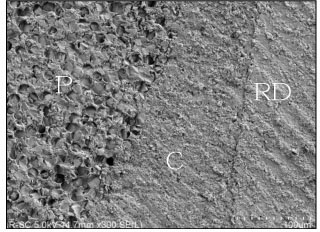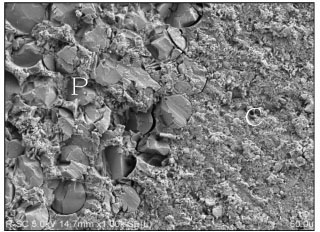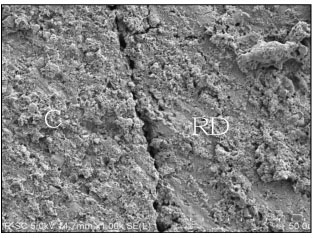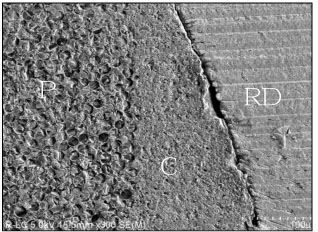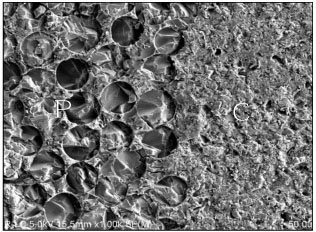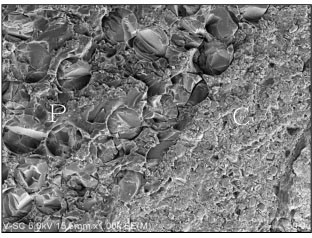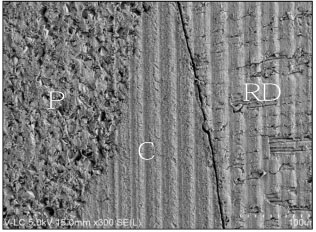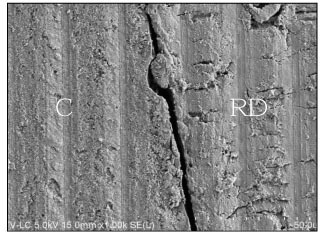Effect of curing methods of resin cements on bond strength and adhesive interface of post
- Affiliations
-
- 1Department of Conservative Dentistry, Colledge of Dentistry, Chosun University, Korea. ygcho@chosun.ac.kr
- KMID: 2294351
- DOI: http://doi.org/10.5395/JKACD.2009.34.2.103
Abstract
- The purpose of this study was to compare the effect of curing methods of adhesive resins and resin cements in the root canal. Crown portions of 32 single-rooted mandibular premolars were removed. Routine endodontic treatment was done, and 9 mm deep post spaces were prepared within root canals. No. 3 FRC Postec posts (Ivoclar-Vivadent AG, Liechtenstein) were cemented in the post spaces by self-(SC) or light-curing (LC) using two dual-cured adhesives (Adper Scotchbond multi-purpose plus and Exite DSC )and resin cements (RelyX ARC and Variolink II). They were assigned to 4 groups (n=8); R-SC, R-LC, V-SC, V-LC group. After stored in distilled water for 24 hours, each root was transversally sectioned with 1.5 mm thick and made three slices. The specimens were subjected to push-out test in a universal testing machine (EZ Test, Shimadzu Co., Japan) with a crosshead speed of 1 mm/min. The data were analyzed with repeated ANOVA and one-way. ANOVA. Also the interface of post-resin cement and resin cement-canal wall of each group was observed under FE-SEM. When fiber posts were cemented into the root canal using total-etch adhesives, the bond strength and adaptation between post and root canal dentin was affected by curing method. Self-cure of adhesives and resin cements showed higher bond strength and closer adaptation than light-cure of them.
Keyword
MeSH Terms
Figure
Cited by 4 articles
-
Effect of surface treatments of fiber posts on bond strength to composite resin cores
Hye-Jo Keum, Hyun-Mi Yoo
J Korean Acad Conserv Dent. 2010;35(3):173-179. doi: 10.5395/JKACD.2010.35.3.173.Comparison of push-out bond strength of post according to cement application methods
Seo-Ryeong Kim, Jiwan Yum, Jeong-Kil Park, Bock Hur, Hyeon-Cheol Kim
J Korean Acad Conserv Dent. 2010;35(6):479-485. doi: 10.5395/JKACD.2010.35.6.479.Effect of surface treatment of FRC-Post on bonding strength to resin cements
Chan-Hyun Park, Se-Hee Park, Jin-Woo Kim, Kyung-Mo Cho
J Korean Acad Conserv Dent. 2011;36(2):125-131. doi: 10.5395/JKACD.2011.36.2.125.Retentive strength of different intracanal posts in restorations of anterior primary teeth: an in vitro study
Mahtab Memarpour, Fereshteh Shafiei, Maryam Abbaszadeh
Restor Dent Endod. 2013;38(4):215-221. doi: 10.5395/rde.2013.38.4.215.
Reference
-
1. Sorensen JA, Engelman MJ. Effect of post adaptation on fracture resistance of endodontically treated teeth. J Prosthet Dent. 1990. 64:419–424.
Article2. Vichi A, Grandini S, Davidson CL, Ferrari M. An SEM evaluation of several adhesive systems used for bonding fiber posts under clinical conditions. Dent Mater. 2002. 18:495–502.
Article3. Morfis AS. Vertical root fracture. Oral surg Oral Med Oral Pathol. 1990. 69:631–635.4. Lassila LVJ, Tanner J, Bell AM, Narva KN, Vallittu PK. Flexural properties of fiber reinforced root canal posts. Dent Mater. 2004. 20:29–36.
Article5. Mannocci F, Qualtrough AJ, Worthington HV, Watson TF, Pitt-Ford TR. Randomized clinical comparison of endodontically treated teeth restored with amalgam or fiber posts and resin composite: five year results. Oper Dent. 2005. 30:9–15.6. Perdigao J, Gomes G, Lee IK. The effect of silane on the bond strengths of fiber posts. Dent Mater. 2006. 22:752–758.
Article7. Asmussen E, Peutzfeldt A, Heitmann T. Stiffness, elastic limit, and strength of newer types of endodontic post. J Dent. 1999. 27:275–278.8. Song MH, Park SJ, Cho HG, Hwang YC, Oh WM, Hwang IN. Influence of adhesive application on shear bond strength of the resin cement to indirect resin composite. J Korean Acad Conserv Dent. 2008. 33:419–427.
Article9. Ferrari M, Vichi A, Grandini S. Efficacy of different adhesive techniques on bonding to root canal walls: an SEM investigation. Dent Mater. 2001. 17:422–429.
Article10. Bouillaguet S, Troesch S, Wataha JC, Krejci I, Meyer JM, Pashley DH, Microtensile bond. Microtensile bond strength between adhesive cements and root canal dentin. Dent Mater. 2003. 19:199–205.
Article11. Escribano N, Macorra JC. Microtensile bond strength of self-adhesive luting cements to ceramic. J Adhes Dent. 2006. 8:337–341.12. Park JS, Kim JS, Kim MS, Son HH, Kwon HJ, Cho BH. Aging effect on the microtensile bond strength of self-etching adhesive. J Korean Acad Conserv Dent. 2006. 31:415–425.
Article13. Oliveira SSA, Pugach MK, Hilton JF, Watanabe LG, Marshall SJ, Marshall GW Jr. a self-etching primer vs a total-etch system. Dent Mater. 2003. 19:758–767.14. Kim DS, Park SH, Choi GW, Choi KK. The effect of bonding resin on bond strength of dual-cure resin cements. J Korean Acad Conserv Dent. 2007. 32:426–436.
Article15. Dallari A, Rovatti A, Dallan B, Mason PN, Suh BI. Translucent quartz-fiber post luted in vivo with selfcuring composite cement: Case report and microscopic examination at a two-year clinical follow-up. J Adhes Dent. 2006. 8:189–195.16. Monticelli F, Grandini S, Goracci C, Ferrari M. Clinical behavior of translucent fiber posts: a 2-year prospective study. Int J Prosthodont. 2003. 16:593–596.17. Valandro LF, Filho ODA, Valera MC, de Araujo MAM. The effect of adhesive systems on the pullout strength of a fiberglass-reinforced composite post system in bovine teeth. J Adhes Dent. 2005. 7:331–336.18. Goracci C, Tavares AU, Fabianelli A. The adhesion between fiber posts and root canal walls: comparison between microtensile and push-out bond strength measurements. Eur J Oral Sci. 2004. 112:353–361.
Article19. Valandro LF, Filho ODA, Valera MC, de Araujo MAM. The effect of adhesive systems on the pullout strength of a fiber glass-reinforced composite post system in bovine teeth. J Adhes Dent. 2005. 7:331–336.20. Goracci C, Fabianelli A, Sadek FT, Papacchini F, Tay FR, Ferrari M. The contribution of friction to the dislocation resistance of bonded fiber posts. J Endod. 2005. 31:608–612.
Article21. Magni E, Mazzitelli C, Papacchini F, Radovic I, Goracci C, Coniglio I, Ferrari M. Adhesion between fiber posts and resin luting agents: A microtensile bond strength test and SEM investigation following different treatment of the post surface. J Adhes Dent. 2007. 9:195–202.22. Arrais CAG, Giannini M, Rueggeberg FA, Pashley DH. Effect of curing mode on micotensile bond strength to dentin of two dual-cured adhesive systems in combination with resin luting cements for indirect restorations. Oper Dent. 2007. 32:37–44.
Article23. Asmussen E, Peutzfeldt A. Bonding of dual-curing resin cements to dentin. J Adhes Dent. 2006. 8:299–304.24. Ceballos L, Garrido MA, Fuentes V, Rodriguez J. Mechanical characterization of resin cements used for luting fiber posts by nanoindentation. Dent Mater. 2007. 23:100–105.
Article
- Full Text Links
- Actions
-
Cited
- CITED
-
- Close
- Share
- Similar articles
-
- Effect of dentin pretreatment and curing mode on the microtensile bond strength of self-adhesive resin cements
- Effect of dentin surface wetness on tensile bond strength of self adhesive resin cements
- Simple methods to enhance bond strength of self-adhesive resin cements
- Evaluation of mechanical properties of several dual-cure resin cements by curing modes
- Effect of an intermediate bonding resin and flowable resin on the compatibility of two-step total etching adhesives with a self-curing composite resin


